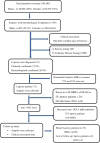Reaching those at risk: Active case detection of leprosy and contact tracing at Kokosa, a hot spot district in Ethiopia
- PMID: 37343000
- PMCID: PMC10284383
- DOI: 10.1371/journal.pone.0264100
Reaching those at risk: Active case detection of leprosy and contact tracing at Kokosa, a hot spot district in Ethiopia
Abstract
Introduction: Leprosy is a chronic mycobacterial disease of public health importance. It is one of the leading causes of permanent physical disability. The prevalence of leprosy in Ethiopia has remained stagnant over the last decades. The aim of the study was to identify new leprosy cases and trace household contacts at risk of developing leprosy by active case detection. The study area was Kokosa district, West Arsi zone, Oromia region, Ethiopia.
Method: A prospective longitudinal study was conducted from June 2016-September 2018 at Kokosa district. Ethical approvals were obtained from all relevant institutions. Health extension workers screened households by house-to-house visits. Blood samples were collected and the level of anti-PGL-I IgM measured at two-time points.
Results: More than 183,000 people living in Kokosa district were screened. Dermatologists and clinical nurses with special training on leprosy confirmed the new cases, and their household contacts were included in the study. Of the 91 new cases diagnosed and started treatment, 71 were recruited into our study. Sixty-two percent were males and 80.3% were multibacillary cases. A family history of leprosy was found in 29.6% of the patients with cohabitation ranging from 10 to 30 years. Eight new leprosy cases were diagnosed among the 308 household contacts and put on multi-drug therapy. The New Case Detection Rate increased from 28.3/100,000 to 48.3/100,000 between 2015/2016 and 2016/2017. Seventy one percent of leprosy patients and 81% of the household contacts' level of anti-PGL-I IgM decreased after treatment. In conclusion,the results of the study showed the importance of active case detection and household contact tracing. It enhances early case finding, and promotes early treatment, thereby interrupting transmission and preventing potential disability from leprosy.
Copyright: © 2023 Lema et al. This is an open access article distributed under the terms of the Creative Commons Attribution License, which permits unrestricted use, distribution, and reproduction in any medium, provided the original author and source are credited.
Conflict of interest statement
The authors have declared that no competing interests exist.
Figures






References
-
- Organization W.H., Global leprosy (Hansen disease) update, 2020: impact of COVID-19 on global leprosy control. WklyEpidemiol Rec, 2021. 96(36): p. 421–444.
-
- WHO, Global leprosy update, 2018: moving towards a leprosy-free world–Situation de la lèpre dans le monde, 2018: parvenir à un monde exempt de lèpre. Weekly Epidemiological Record = Relevé épidémiologique hebdomadaire, 2019. 94(35/36): p. 389–411.
-
- Organization W.H., Towards zero leprosy. Global leprosy (Hansen’s Disease) strategy 2021–2030. 2021.
-
- Moet FJ, e.a., Risk factors for the development of clinical leprosy among contacts, and their relevance for targeted interventions. Lepr rev, 2004. 75: p. 310–26. - PubMed
Publication types
MeSH terms
Substances
LinkOut - more resources
Full Text Sources
Medical

